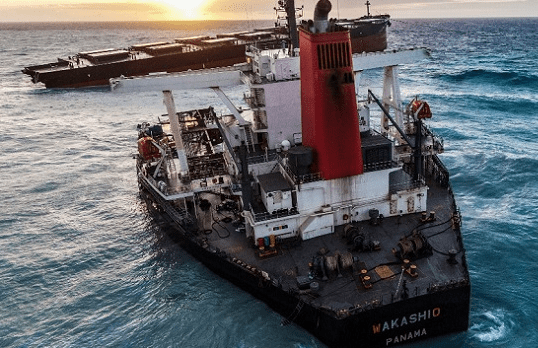Six months after the scuttling of the Wakashio’s bow, the dismantling of the stern has finally kicked off in Pointe d’Esny, Mauritius. The parts will be transported on a special barge to Port-Louis’ harbor before being handed over to a local scrap metal recycling specialist.
The operation kicked into gear on Monday with experts from the Chinese company Lianyungang Dali Underwater Engineering on-site for the dismantling of the 75-meter bow of the Wakashio, which has been stuck on the reef since last July.
The operation, which is expected to be completed by the end of March depending on weather conditions, comes six months after the bow of the 225-meter long ore carrier was scuttled by the Dutch salvage company Smit International about 20 nautical miles from Old Grand Port.
The stern removal will involve the Hong Bang 6, a crane barge specialized in this type of work and one of three of its kind in the world. The vessel arrived in Mauritius a week ago along with the Xin Guang Ha, a semi-submersible heavy-lift ship operated by COSCO Shipping.
The crane barge is already on site alongside three tugs. The dismantled parts will be placed aboard before being sent to Port Louis for a depollution exercise and to be cut into smaller pieces. The parts will then be handed over to Samlo, a local specialist in the recycling of scrap metal. Although the risk of pollution is considered to be low, the Greek firm Polyeco has lined up a skimmer boat on site while anti-pollution booms have been installed around the neighboring Blue Bay Marine Park, a designated Ramsar site.
The MV Wakashio was on its way from China to Brazil when it approached the Mauritian coast to pick up cell phone signal on July 25, 2020. As the team was celebrating an engineer’s birthday, no one noticed that the ship was heading straight for land. It was only after the ore carrier drifted onto the reefs that the Coast Guard was finally able to contact the captain.
There is every reason to believe that the Mauritian authorities did not initially take into account the gravity of the situation, as one of the three tanks ruptured a fortnight later due to the stress on the hull. Nearly 1,000 tonnes of fuel spilled into the lagoon. The oil spread as no anti-pollution barrier had been installed. The MV Wakashio finally broke into two a few days later.
While the wreck removal is on-going, the Court of investigation is continuing to hear witnesses. First Officer Subodha Janendra Tilakaratna has pointed blame on the Indian Captain Sunil Kumar Nandeshwar, saying that the captain had made the decision to move closer to the Mauritian coast. He also admitted last week that he had lied in an initial statement that the weather was not good that night. In detention along with the captain, the Sri Lankan First Officer also said he did not hear calls from the coastguard when the ship was dangerously close to shore. The captain was watching TV when the alarms went off to indicate that the ship was no longer in deep water.
This week, the captain blamed the First Officer, saying he did not comply with his instructions. He also admitted having consumed alcoholic drinks that night.
Visiting the site on Wednesday, Sudheer Maudhoo, the minister of Blue Economy, Marine Resources, Fisheries and Shipping, indicated that Mauritian authorities have decided to place anti-pollution booms in two specific sites on Mauritius’ south coast to prevent the recurrence of such an accident. In June 2016, the MV Benita got stuck on the reefs of Le Bouchon, some kilometers away from Pointe d’Esny, while on its way to Durban. A brawl in the machine room led to that previous accident.
Copyright Ships & Ports Ltd. Permission to use quotations from this article is granted subject to appropriate credit given to www.shipsandports.com.ng as the source.
